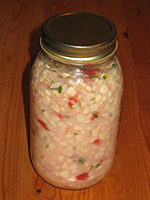 I love raw carrots, but I like cooked carrots even more. I didn’t eat them often, because of all that slicing and then all that standing over the steamer on the stove top. A few months ago, my kids’ liking for cooked carrots inspired me. If they’ll eat their veggies without complaint, by golly, I’ll cook carrots. But there had to be a better way.
I love raw carrots, but I like cooked carrots even more. I didn’t eat them often, because of all that slicing and then all that standing over the steamer on the stove top. A few months ago, my kids’ liking for cooked carrots inspired me. If they’ll eat their veggies without complaint, by golly, I’ll cook carrots. But there had to be a better way.
The trick, for me, was bite-sized chunks (not coin-sized slices) and oven baking instead of stove top steaming. The result . . . I find I prefer them to the steamed variety! The flavor is more intense, less watered down.
Baked Carrots
10 large carrots
1/3 cup butter
7” x 11” glass baking dish
Scrub the carrots well, then peel them. Carrots, unlike many other vegetables and fruits, do not store the majority of their nutrients in the skin. Good stuff spreads bountifully through the entire root.
Cut off the tops and discard. Slice the carrots into bite-sized chunks. This goes so much faster than slicing them into coin-sized rounds. You’ll be amazed.
Use a small pat of butter to grease your baking dish. Toss the remnant in with the rest of the butter stick and melt. Place the carrots in the baking dish and drizzle the melted butter over them, coating their surfaces well.
Cover the dish and place in a 350F oven.
Bake for 1 hour.
Be careful removing the cover. The steam contained within is very hot and can burn you.
A Word About Butter
Old-style margarine was chock full of transfats. We now know that transfats are so injurious to the human body that there is no known safe level for eating them. (Talk to the actual fats researchers. They know!)
Enter new-style margarines with “no” transfats.
But . . . there is a big but. Actually three but’s.
First, if the amount of transfat in the margarine is below a certain level, the manufacturer is allowed to claim zero transfats on the label. But that legal “zero” is not what you and I mean by zero. And given how harmful the transfats are, I want that zero to mean literally none at all. It doesn’t.
The second problem is more obscure. It has to do with polyunsaturated fats. (Margarines are made from polyunsarurates.) Until the modern era, humans ate very few. They occurred naturally in grains and cheese and meat and fish, but constituted less than 4% of of the calories ingested.
The process by which we switched to eating nearly 30% of our calories from polyunsaturated fats owes more to corporate greed (a lot of money to be made in corn oil) and political interference than good research. Political correctness may demand we consume corn oil and safflower oil and such, but this political correctness does not dovetail well with good health! Our bodies weren’t made to handle the load.
The third issue with polyunsaturates concerns the manufacturing process. The oils are processed at very high heats. Because polyunsaturates are very fragile, they break down easily. Becoming rancid under the high factory heat, they smell and taste so awful that no one would put them anywhere near the mouth! So the manufacturers must then use harsh chemical scrubbers to remove the odor. Some residues of the chemicals remain in the oils.
Do yourself a favor: cook with butter and extra-virgin olive oil.
More Recipes
Sauerkraut
Sautéed Eggplant
Coconut Salmon



 Sauerkraut
Sauerkraut